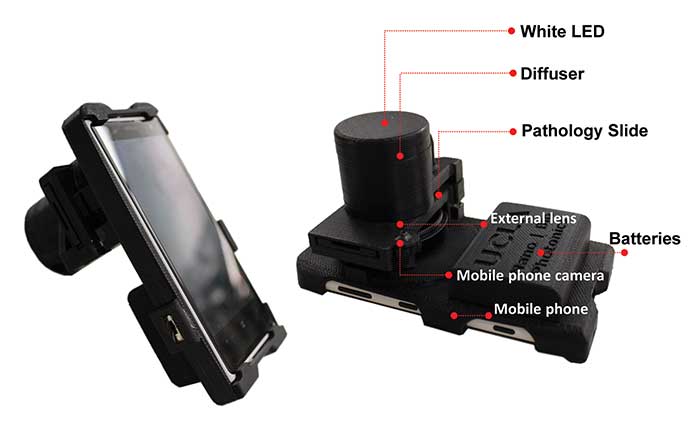In regions where disease risk is high and pathology labs are scarce, portable optical devices are providing much-needed diagnoses.
 Nowhere does the burden of disease weigh as heavily on people as it does in the low-resource settings of the developing world. Residents in parts of Asia, Africa and South America are highly vulnerable to communicable diseases such as malaria and tuberculosis. They also face increasing risk of developing noncommunicable “lifestyle” diseases common in the developed world such as obesity, high blood pressure and cancer.
But people in low-resource regions don’t have access to the level of medical testing residents of wealthier countries enjoy and assume. One study from 2013, for example, estimates that pathology coverage in Sub-Saharan Africa is about one-tenth of that in the developed world. The consequences are stark: Diseases that are treatable or preventable in the developed world kill people in less developed regions.
Photonics research and innovation, particularly in the fields of microscopy and imaging, are making incredible strides to alter this picture through low-cost portable optical imaging devices capable of bringing improved medical diagnostics to some of the poorest regions in the world.
One such device is the EVA (Enhanced Visual Assessment) System, an integrated, cloud-supported digital tool that screens for cervical cancer. Brought out by MobileODT of Tel Aviv, Israel, the handheld EVA System, which weighs a mere 450 grams, makes use of a smartphone camera to function as a mobile colposcope. As a light source, the system uses a compact high-power LED with extremely low thermal resistance and cross-polarization to reduce glare. It also comes with an external lens capable of up to 17× magnification.
“Adding external optics to the smartphone lens is an optomechanical challenge and has several effects on imaging,” said David Levitz, co-founder and chief technical officer of MobileODT. “First, less light reaches the camera, which impacts your SNR [signal-to-noise ratio]. Second, with every piece of hardware added, there are higher chances of misalignment. Third, each smartphone camera has unknown Bayer filters and an IR-blocking filter that alter the light reaching the sensor and closed camera-control algorithms that further manipulate the images.”
Nowhere does the burden of disease weigh as heavily on people as it does in the low-resource settings of the developing world. Residents in parts of Asia, Africa and South America are highly vulnerable to communicable diseases such as malaria and tuberculosis. They also face increasing risk of developing noncommunicable “lifestyle” diseases common in the developed world such as obesity, high blood pressure and cancer.
But people in low-resource regions don’t have access to the level of medical testing residents of wealthier countries enjoy and assume. One study from 2013, for example, estimates that pathology coverage in Sub-Saharan Africa is about one-tenth of that in the developed world. The consequences are stark: Diseases that are treatable or preventable in the developed world kill people in less developed regions.
Photonics research and innovation, particularly in the fields of microscopy and imaging, are making incredible strides to alter this picture through low-cost portable optical imaging devices capable of bringing improved medical diagnostics to some of the poorest regions in the world.
One such device is the EVA (Enhanced Visual Assessment) System, an integrated, cloud-supported digital tool that screens for cervical cancer. Brought out by MobileODT of Tel Aviv, Israel, the handheld EVA System, which weighs a mere 450 grams, makes use of a smartphone camera to function as a mobile colposcope. As a light source, the system uses a compact high-power LED with extremely low thermal resistance and cross-polarization to reduce glare. It also comes with an external lens capable of up to 17× magnification.
“Adding external optics to the smartphone lens is an optomechanical challenge and has several effects on imaging,” said David Levitz, co-founder and chief technical officer of MobileODT. “First, less light reaches the camera, which impacts your SNR [signal-to-noise ratio]. Second, with every piece of hardware added, there are higher chances of misalignment. Third, each smartphone camera has unknown Bayer filters and an IR-blocking filter that alter the light reaching the sensor and closed camera-control algorithms that further manipulate the images.”
Member Exclusive: To read the complete article, please Login or Register